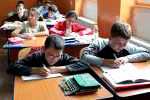Activity of the primary and general secondary education institutions, beginning of the school year 2014/15
National Bureau of Statistics informs that, network of primary and general secondary education is constituted of 1347 units, including 1345 day schools and 2 evening schools. The majority of primary and general secondary education (98,9%) represents public property.
1430
Activity of higher education institutions in 2014/15 academic year
National Bureau of Statistics informs that, the higher education network is constituted from 31 units, of which 19 public institutions and 12 - non-public (with 1 unit less compared to previous year). Of the total public institutions, 2 institutions have only Cycle II - Master degree studies.
1018
Activity of institutions of secondary vocational and secondary specialized education in 2014/15 school year
National Bureau of Statistics informs that, during the academic year 2014/15, the network of institutions of professional education covered 61 units, including 46 vocational schools and 15 schools of trades. During the academic year 2014/15, secondary spoecialised education was organised in 45 colleges, including 41 public and 4 non-public colleges.
1111
Research and development activity in 2013
National Bureau of Statistics informs that, the research and development activity in 2013 was conducted in 64 units, of which 40 institutes and/or research centres, 15 higher education institutions and 9 other types of units. From the total number of units, 53 units or 82,8% are in state ownership compared to 79,7% in 2012.
1547
Doctoral and postdoctoral activity in 2013
National Bureau of Statistics informs that, in 2013 doctoral studies were conducted in 49 institutions, including 31 research institutes and 18 higher education institutions. Number of doctorates was 1522 persons (excluding foreign), increasing by 2,5% compared to 2012.
1127
Activity of the primary and general secondary education institutions, beginning of the school year 2013/14
National Bureau of Statistics informs that network of primary and general secondary education is constituted of 1374 schools, gymnasiums and lyceums, including 1372 day schools and 2 evening schools. The majority of primary and general secondary education (98,7%) represents public property. At the same time, in the country activated 18 non-public lyceums which are located only in urban areas.
1596
Activity of institutions of secondary vocational and secondary specialized education in 2013/14 school year
National Bureau of Statistics informs that, during the academic year 2013/14, the network of institutions of professional education covered 67 institutions of secondary vocational education, including 2 vocational lyceums, 44 vocational schools and 21 schools of trades (of which 6 units nearby penitentiary institutions).
958
Activity of higher education institutions in 2013/14 academic year
National Bureau of Statistics informs that the higher education network is constituted from 32 units, of which 19 public institutions and 13 - non-public (with 2 units less compared to previous year). Only two of the 19 state institutions have the Cycle II - Master degree studies.
1105
Research and development activity in 2012
National Bureau of Statistics informsб that the research and development (R&D) activity in 2012 was conducted in 69 units, of which 43 institutes and/or research centres, 15 higher education institutions and 11 other types of units. From the total number of units, 55 units or 79,7% are in state ownership compared to 81,3% in 2011.
1591
Doctoral and postdoctoral activity in 2012
National Bureau of Statistics informs that in 2012 doctoral studies were held in 47 institutions, including 31 scientific research institutions and 16 higher education institutions. Overall, there was registered a decrease in the number of doctoral students, from 1667 persons in 2005 to 1485 persons in 2012 (excluding foreign students).
1158
Activity of primary and general secondary education institutions at the beginning of 2012/2013 school year
National Bureau of Statistics informs, that at the beginning of 2012/2013 school year, the network of primary and general secondary education institutions included 1397 schools, gymnasiums and lyceums, including 3 evening schools and 1394 day schools. Day education is organized in 108 primary schools, 767 gymnasiums, 491 lyceums and 28 schools for children with delays in the intelectual or physical development.
1518
Activity of institutions of secondary vocational and secondary specialized education in 2012/13 school year
National Bureau of Statistics informs that, as a result of the optimization of secondary vocational institutions network, in the 2012/13 school year, the number of institutions has decreased with 3 units compared to previous year, and constituted 67 units (including 2 private institutions). Thus, the secondary vocational institutions network comprises 2 vocational lyceums, 44 vocational schools and 21 schools of trade (including 6 schools under the penitentiaries).
987
Activity of higher education institutions in 2012/13 academic year
National Bureau of Statistics informs that the higher education network is constituted from 34 units, of which 19 public institutions and 15 - non-public. At the beginning of academic year 2012/13 number of students was 102,5 thou. persons (excluding foreign students), or with 1,4% less compared to previous year. The decrease in the number of the students was caused by the decrease in the number of the students in the state institutions. In average, per 10 thousands inhabitatbts there were 288 students in higher education institutions.
970
Research and development activity in 2011
National Bureau of Statistics informs that the research and development (R&D) activity in 2011 was conducted in 64 units, of which 42 institutes and/or research centres, 13 higher education institutions and 9 - other types of units. From the total number of units, 52 units (81,3%) are in state ownership.
1295
Doctoral and postdoctoral activity in 2011
National Bureau of Statistics informs that in 2011 doctoral studies were held in 46 institutions, including 31 scientific research institutions and 15 higher education institutions. The total number of doctoral students (excluding foreign students) was 1556 persons, whiсh is nearly the same number as in the previous year.
954
Activity of primary and general secondary education institutions at the beginning of 2011/2012 school year
National Bureau of Statistics informs, that at the beginning of 2011/12 school year, the network of primary and general secondary education institutions included 1460 schools, gymnasiums and lyceums, including 3 evening schools and 1457 day schools. Day education is organized in 83 primary schools, 829 gymnasiums, 497 lyceums, 19 general schools, 29 schools for children with delays in the intelectual or physical development.
1543
Activity of institutions of secondary vocational and secondary specialized education in 2011/12 school year
National Bureau of Statistics informs that as a result of the optimization of secondary vocational institutions network, in the 2011/12 school year, the number of institutions has decreased with 5 units compared to previous year, and constituted 70 units (including 2 private institutions).
1084
Activity of higher education institutions in 2011/12 academic year
National Bureau of Statistics informs that the higher education network is constituted from 34 units, of which 19 public institutions and 15 - non-public.
1058
Research and development activity in 2010
National Bureau of Statistics informs that the research and development (R&D) activity in 2010 was conducted in 62 units, of which 38 institutes and/or research centres, 12 higher education institutions and 12 - other types of units. From the total number of units, 51 units (82,3%) are in state ownership.
1143
Doctoral and postdoctoral activity in 2010
National Bureau of Statistics informs that in 2010 doctoral studies were held in 45 institutions, including 30 scientific research institutions and 15 higher education institutions.
954
Activity of primary and general secondary education institutions at the beginning of 2010/2011 school year
National Bureau of Statistics informs that at the beginning of 2010/11 school year, the network of primary and general secondary education institutions included 1489 schools, gymnasiums and lyceums, including 5 evening schools and 1484 day schools.
1589
Activity of institutions of secondary vocational and secondary specialized education in 2010/11 school year
National Bureau of Statistics informs that at the beginning of the 2010/11 school year, secondary vocational education network comprised 75 units, of which 2 are non-public. As in the previous years, secondary vocational education network consisted of 23 schools of trades (including 6 schools as under the penitentiaries) and 52 vocational schools.
1007
Activity of higher education institutions in 2010/11 academic year
National Bureau of Statistics informs that the higher education network is constituted from 33 units, including 19 public institutions. At the beginning of academic year 2010/11 number of students was 107,8 thou. persons (excluding foreign students), which is less with 1,9% compared to previous year.
1019
Doctorate and post-doctorate activity in 2009
National Bureau of Statistics informs that in 2009 doctorate studies took place in 44 institutions, including in 29 research and development institutions and 15 higher education institutions.
909
Research and development activity in 2009
National Bureau of Statistics releases data on Research & Development (R&D) in 2009. R&D activity in 2009 was conducted in 68 institutions (organisations), 55 of which being public institutions or 80,9% from total institutions/organisations. From the total number of institutions, 41 units are specialized in R&D, 10 design and construction offices, 3 design and project engineering units in constructions, 12 higher education institutions, one unit with experimental base status and an industrial enterprise.
934
Activity of institutions of secondary vocational and secondary specialized education in academic year 2009/2010
National Bureau of Statistics presents data on the activity of institutions of secondary vocational and secondary specialized education in academic year 2009/2010.
932
Activity of institutions of higher education in academic year 2009/2010
National Bureau of Statistics presents data on the activity of institutions of higher education in academic year 2009/2010.
1000
Activity of primary and secondary education institutions at the beginning of 2009/2010 school year
National Bureau of Statistics announces that at the beginning of 2009/2010 school year, the network of primary and secondary education institutions covered 1512 schools, gymnasiums and lyceums, including 7 evening schools and 1505 day schools, of which: 91 primary schools, 708 gymnasiums, 492 lyceums, 179 general schools, 35 schools for mental or physically handicapped children.
1561
Research-development works in 2008
National Bureau of Statistics presents data on research-development works in 2008.
941
Activity of institutions of higher education in academic year 2008/2009
National Bureau of Statistics presents data on the activity of institutions of higher education in academic year 2008/2009.
880
reset WAYcursor WAYcontrast WAYMarire Font WAYCiteste cu voce textul selectat WAYLinkuri WAY































